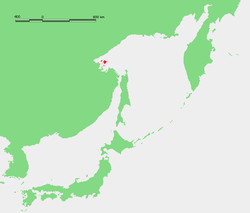Shantar Islands
| Shantar Islands Острова Шантарские | |
|---|---|
| Island group | |
|
Map of the Shantar Islands. | |
 Location of the Shantar Islands in the Sea of Okhotsk. | |
| Country | Russian Federation |
| Federal subject | Far Eastern Federal District |
| Krai | Khabarovsk Krai |
| Elevation | 720 m (2,360 ft) |
The Shantar Islands (Russian: Острова Шантарские, Ostrova Shantarskiye) are a group of fifteen islands located off the western shore of the Sea of Okhotsk in Uda Bay.[1] Most of the islands have rugged cliffs, but they are of moderate height; the highest point in the island group is 720 metres.
Geography
The island group is administered by Russia as part of Khabarovsk Krai.[2]
Islands
- Bolshoy Shantar Island. The largest island in the Shantar group, with an area of 1790 km2. It is about 72 km in length and 49 km in width. It has a large brackish lake (Lake Bol'shoe) in its northern end which is connected to the sea through a narrow passage. Smelts (Hypomesus japonicus and olidus) are found in this lake.[3]
- Feklistova Island, with an area of 372 km2.
- Malyy Shantar Island, with an area of 100 km2.
- Medvezhiy, located very close to the coast.
- Belichiy, with an area of 70 km2.
- Other islands include Prokofyeva, Sakharnaya Golova, Kusova, Ptichiy, Utichiy and Yuzhnyy.
History
The islands are currently uninhabited but were known to the mainland Gilyak tribes for their fishing grounds.
The first recorded exploration of the Shantar Islands was in April 1640, when Russian explorer Ivan Moskvitin allegedly sailed to the mouth of the Amur River with a group of Cossacks and spotted the Shantar Islands on the way back. Moskvitin reported his discoveries to Prince Shcherbatov, the Muscovite voivode in Tomsk. Based on Ivan Moskvitin's account, the first Russian map of the Far East was drawn in March 1642. The Shantar Islands were also explored by Russian surveyors between 1711 and 1725.[4]
At the end of 2013, the Shantar Islands National Park was created by Russian scientists and conservationists with support from WWF and several international organizations to protect the wildlife of the islands.[5]
Ecology
There is no permanent population on the Shantar Islands, but they are often visited by commercial fishermen who use them as a base. Other economic activities undertaken on these islands are fur hunting and trapping as well as logging, which in the past were often done illegally.[7] There are spruce forests on the largest islands.[8] Other trees in the island taiga are the Siberian spruce, the Dahurian larch and the mountain pine.
There are many endangered birds in these islands, including the Blakiston's fish owl, osprey, black stork, red-necked grebe, gyrfalcon, solitary snipe, Steller's sea eagle and the Siberian grouse.[9]
The Kamchatka brown bear (Ursus arctos beringianus), sable and marten, caribou, red fox, and river otter are common on the Shantar Islands.[10] Reindeer can be seen as well. Rivers on these islands are populated by sturgeon, salmon, trout, and various other fish.
The waters around these coastal islands are frozen for about eight months of the year on average. Pinnipeds (such as harbour seals, bearded seals, common seals, ribbon seals (on sea ice) and Steller sea lions), sea otters, and cetaceans such as minke whales, killer whales, and the critically endangered bowhead whales, North Pacific right whales, western gray whales and belugas can be seen in the waters off the islands and come very close to shore.
Although there is little visible evidence of human impact, the Shantar island ecosystem is under threat. One of the most severe threats to the environment of the Shantar Islands is a proposed tidal hydroelectric power station, which is currently on hold for lack of funds.[11] Lack of restrictions on tourism and resorting is also a problem as the number of people visiting the islands is increasing in recent years.
Nearby islands
- Menshikov Island (Остров Меньшикова; Ostrov Men'shikova) 54°36′N 139°14′E / 54.600°N 139.233°E lies 71 km to the east of Kusov Island's eastern shore. It is 7 km long and has a maximum width of 1.6 km.
- Reyneke Island (Остров Рейнеке; Ostrov Reyneke) 54°19′N 139°47′E / 54.317°N 139.783°E lies 45 km to the southeast of Menshikov Island. It is 7 km long and has a maximum width of 1.6 km. It is located close to a headland in the coast, separated from it by a 5 km wide sound. This island should not be confused with Reyneke Island close to Russky Island in the Vladivostok Bay.
See also
References
- ↑ Location
- ↑ Khabarovsk Krai
- ↑ Lake Bol'shoe
- ↑ From the History of the Great Russian Geographical Discoveries in the Arctic and Pacific Oceans in the Seventeenth and First Half of the Eighteenth Centuries. by A. V. Efimov
- ↑ Interfax. 2014 Govt establishes Shantar Islands National Park Russia Beyond The Headlines. retrieved on 02 June 2014
- ↑ Vladislav Raevskii. retrieved on 01 June 2014
- ↑ Illegal hunting and fishing in the Shantarskiye Islands
- ↑ Taiga in the Shantarskiye Islands
- ↑ Russian Conservation; Endangered Ecosystems, The Shantar Islands, page 7. retrieved on 02 June 2014
- ↑ Fauna
- ↑ Russian Conservation; Endangered Ecosystems, The Shantar Islands, page 8
